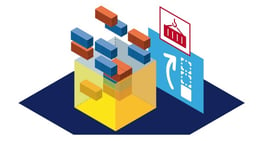5 Tactics for Accelerating Industry 4.0 Adoption
Brian Hoey - December 10, 2020

 According to McKinsey, COVID-19 has already had a marked impact on Industry 4.0 adoption in the industrial sector. For businesses that were already making the kind of digital transformation required to operationalize the paradigms of the fourth industrial revolution, the pandemic has had the effect of accelerating their rate of change. In other words, manufacturers on the path to Industry 4.0 have sped up their pace—and the result is a widening gap between the “technology have and have-nots.”
According to McKinsey, COVID-19 has already had a marked impact on Industry 4.0 adoption in the industrial sector. For businesses that were already making the kind of digital transformation required to operationalize the paradigms of the fourth industrial revolution, the pandemic has had the effect of accelerating their rate of change. In other words, manufacturers on the path to Industry 4.0 have sped up their pace—and the result is a widening gap between the “technology have and have-nots.”
Obviously, no supply chain business wants to be left behind. But digital transformation can seem daunting, and even some businesses that are working hard to adapt to these new realities might be wondering where to start. After all, Industry 4.0 technologies are still comparatively new, and there are multiple competing visions for what an Industry 4.0-enabled factory or supply chain might look like. In order to truly accelerate your digital transformation and pave the way for the cyber-physical systems of the future, you’ll need to start by getting a handle on the foundational technologies that will make this paradigm shift possible. From there, you can begin to exploit the interactions between these technologies in such a way as to find new efficiencies and smarter ways of fulfilling customer orders.
1. Move to the Cloud
Not for nothing is the cloud one of the pillars Industry 4.0. Since the cloud is, by its very nature, decentralized and distributed, it can go a long way towards laying the groundwork for the kinds of decentralized processes that smart supply chain management depends on. Thus, if you’re looking to speed up your Industry 4.0 adoption, one of your first tasks should be to examine your existing IT and identify the areas where you could move away from on-premises software deployments and migrate to cloud solutions. Not only will this help you to reduce your internal IT costs, it will also pave the way for easier integration and interoperability between disparate IT solutions—meaning that the different touchpoints on the value chain that utilize those disparate solutions can more easily share data and collaborate. Thus, you increase flexibility and visibility in a way that empowers future process evolutions.
2. Adopt AI-Powered Solutions
AI is, of course, another pillar of Industry 4.0, but for many businesses it seems like a daunting prospect. In reality, however, the barrier to entry for artificial intelligence isn’t really that high. Even your email solution probably uses some amount of machine learning just to figure out what's spam and what isn’t—which means that it shouldn’t be too hard for an S&OP solution, a TMS, or APS software to offer at least some AI integration. Bear in mind that AI can encompass a whole range of technologies, including machine learning, constraint programming, clustering, path search, metaheuristics, and more. Even a solution that isn’t using AI as one of its top selling points might be using metaheuristics to help optimize 3D container loading, or machine learning to help you forecast parts-level demand in the sourcing process, or similar. By factoring this into your vendor selection process, you can ensure that you’re in a position to put data to use as you collect it—rather than letting it sit idle.
3. Train Your Teams on Digital Technology
Most of the items on this list are about technological changes that can give you the tools you need for true digital transformation—but not every facet of Industry 4.0 is technology-driven. As with any other major paradigm shift, people are going to play an important role. After all, you can’t have human-machine cooperation without humans who know what they’re. As such, one of the most important steps you can take before you’ve even figured out what your larger scale Industry 4.0 transformation is going to look like is to train your people on the kinds of digital technologies we’ve been discussing. Intuitive and user-centered AI technology will help to ensure that you don’t need to be a data scientist to improve your demand forecasts—but, all the same, it will be useful going forward to make sure that some of your people are familiar with basic data science concepts, with cloud technology, etc. This helps you to avoid getting stuck with a “skills gap” when you begin to deploy Industry 4.0 improvements in earnest.
4. Prioritize Supply Chain Integration
No transformation of this size happens all at once—which means that between now and full Industry 4.0-readiness you’ll make any number of decisions that don’t appear to be directly related to the larger project. When these decisions are technology-related, however, it’s important to keep your larger goals of digital transformation in view. Thus, for any new process or solution you’re considering, you should ask yourself: “Is this going to be conducive to further supply chain integration?” If the answer is yes—i.e. if the solution shows the flexibility you need to enable data sharing between your production planners and your suppliers, or your transportation planners and your shipping partners—that means you’re on the right path for a more visible end-to-end supply chain. If the answer is no, you may be setting yourself for poor visibility, planning silos, and integration hurdles down the road that prevent you from achieving your larger aims.
5. Automate
More or less the same logic we used above can apply to automation. Any time you’re looking to make a change—whether that’s adopting a new solution or simply adjusting a business process—ask yourself: “Does this lend itself to being automated?” “Will this integrate easily with future automated workflows?” “Is there an alternative that will be more automation-friendly?” Ultimately, you’ll want to use automation to empower autonomous machine decision-making up and down your value chain—and the way to do that is by seeking low level opportunities for automation. This might mean that, presented with multiple S&OP software solutions, you choose the one that automatically compares your forecasted demand to your current capacity. Or, when looking into TMS options, opting for the one that lets you set automated alerts when a bottleneck crops up in your logistics chain. By making choices using these heuristics, you’re able to slowly-but-surely prepare yourself for digital transformation and Industry 4.0 adoption.
LATEST POSTS
- Understand Circular Economy in The Manufacturing Industry
- How Can Industry 4.0 IT Integration Be Achieved Smoothly?
- The Significance of Order Sequencing in Discrete Manufacturing
- How to improve your Supply Chain Management: The Power of Control Towers
- Optimizing Human Resource Scheduling in Manufacturing: A Technological Approach



